No CrossRef data available.
Article contents
Aspects of Truth: A New Religious Metaphysics by Catherine Pickstock, Cambridge University Press, Cambridge, 2020, pp. xx + 324, £29.99, hbk
Review products
Aspects of Truth: A New Religious Metaphysics by Catherine Pickstock, Cambridge University Press, Cambridge, 2020, pp. xx + 324, £29.99, hbk
Published online by Cambridge University Press: 01 January 2024
Abstract
An abstract is not available for this content so a preview has been provided. Please use the Get access link above for information on how to access this content.

- Type
- Reviews
- Information
- Copyright
- Copyright © 2022 Provincial Council of the English Province of the Order of Preachers


